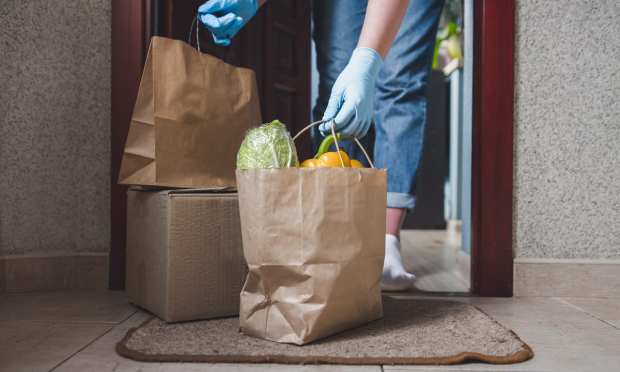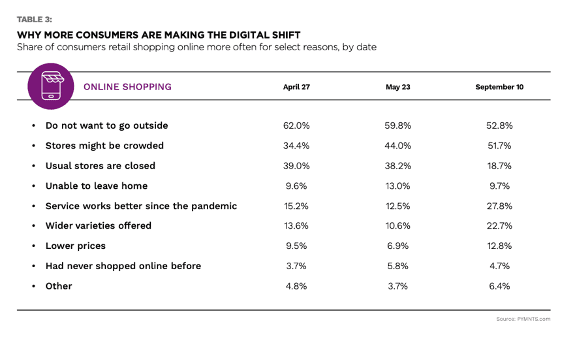COVID Case Spike Adds Fuel To Digital-First Economy

COVID-19 is unfortunately seeing a new wave of infections. Outside of the health concerns and personal toll the disease is taking, the new developments are adding rocket fuel to the digital-first economy. This new acceleration of cases comes at a time when consumers are becoming more deeply ensconced in their new digital shopping and eating habits. This time, however, retailers and restaurants have upped their digital game instead of being caught flat-footed as they were at the beginning of the pandemic.
PYMNTS has been tracking the attitudes and behaviors of consumers since the beginning of the pandemic. It has identified several key dynamics within that period of time that basically show that consumers have spent the period between mid-March and mind-October digitizing their day-to-day routines end to end, and learning that in many ways they like the shift, and are increasingly likely to report they will keep their newly discovered digital habits, even when normal returns.
The most important dynamic is in changing shopping habits and in what consumers are now seeking for digital capabilities. More consumers are shopping online for retail goods, groceries and restaurant orders than ever before, and more are also now saying that they do not intend to go back to shopping in stores once the pandemic recedes.
For example, when consumers shop this holiday season a greater percentage will do so online. When the pandemic started in early March, only 12.3 percent of all shoppers planned to shift their retail shopping from in-store to online. That number gradually rose up to 48.3 percent in August and has now settled at 41.9 percent. Diving deeper into that number, 83.9 percent of those consumers plan to maintain some or all of their newfound retail shopping habits. The primary reason for avoiding physical stores is still fear of contracting COVID-19. It is clearly stated among consumers using online grocery or food aggregators, and takes on more nuance for retail shopping with 52.8 percent of respondents saying they “do not want to go outside” and 51.7 percent wary of crowds in stores.
The biggest change of all will likely be the share of consumers shopping for groceries online. Our research shows that 85.3 percent of consumers who have shifted to grocery shopping online plan to maintain at least some and possibly all of their new digital shopping habits, meaning only 14.7 percent plan to resume shopping in physical grocery stores. This compares to 83.9 percent who plan to maintain some or all of their newfound retail shopping habits and 80.1 percent who plan to maintain some or all of their food ordering habits. A smaller share plan to keep working from home online after the pandemic has subsided: 78.9 percent of those who have shifted to a more remote working arrangement say they will likely keep working remotely to some degree after it does.

The reasoning is more direct when consumers were asked why they wanted to shop with merchants that provide digital purchasing options. The most common reason consumers gave is the fear they of contracting COVID-19. This reasoning is most prevalent among baby boomers. Forty-seven percent of baby boomers and seniors who choose merchants for their digital offerings say it is because they might otherwise contract COVID-19, and 41.5 percent of Generation X consumers and 33.6 percent of millennial consumers say the same.
What would a return to normal look like? The two big things consumers cite are a vaccine and a big drop in COVID-19 cases. Fifty-nine percent reported a vaccine has to be readily available before they would feel comfortable returning to their previous routines, and 58 percent of consumers said they would need to see a decrease in the number of new COVID-19 cases before feeling comfortable returning to their pre-pandemic routines.
The first, we know, is going to be a quite a wait — perhaps even longer than expected since the vaccine’s progress has hit some snags in recent days. Cases, in the U.S. and around the world, are not falling, they are spiking.
The Second Wave Rushes Forward
The U.S. is reporting another record-high average number of new cases of the coronavirus, and top health officials warned Wednesday (Oct 28) that the country is at a “critical point.”
“As the nation did after Memorial Day, we are at another critical point in the pandemic response,” Adm. Brett Giroir, assistant secretary of health who leads the government’s testing effort, said Wednesday on NBC’s “TODAY” show. “Cases are going up in most states across the country. Hospitalizations are up, although we’re still tens of thousands of hospitalizations below where we were in July, but that is rising. And we are starting to see the increase in deaths.”
Thirty-six states are reporting a sharp uptick in hospitalizations, with the number of people admitted for the virus up 5 percent week-on-week at a bare minimum, according to data from the COVID Tracking Project, which tracks testing, hospitalization and other data on the outbreak. Cases are up by at least that amount in 45 states, according to Johns Hopkins data.
And in some places, those figures are quite a bit higher, and more disturbing. In El Paso, Texas, a curfew has been put into place to slow the rate of infection to aid “overwhelmed and exhausted” hospitals and workers. According to CNBC reports, Texas has had an average of about 4,970 COVID-19 patients in hospitals on any given day over the past week, up more than 18 percent compared with the previous week.
The Shutdowns Start Up Again
The situation with rising case numbers and hospitals publicly expressing fears of being overwhelmed in the U.S. mirrors the second wave scenario currently unfolding across the Atlantic in the European Union, as PYMNTS has previously reported.
And as of Wednesday, the EU response to the shutdown is intensifying — both Germany and France announced new nationwide lockdowns. The German shutdown will be four weeks long and entail the closure of restaurants, bars, cinemas, theaters and other leisure facilities in a bid to curb a sharp rise in coronavirus infections.
